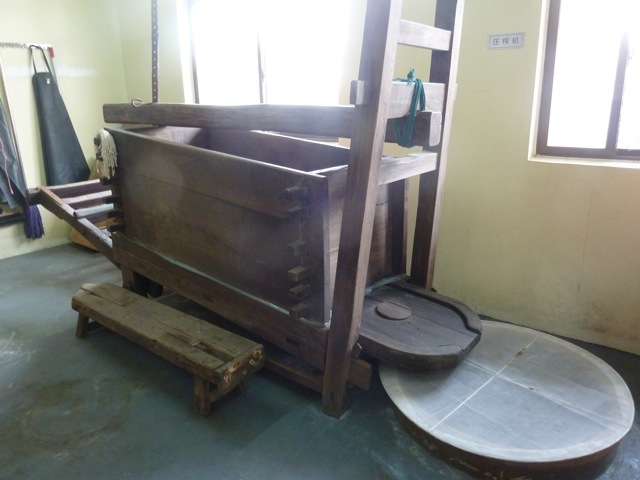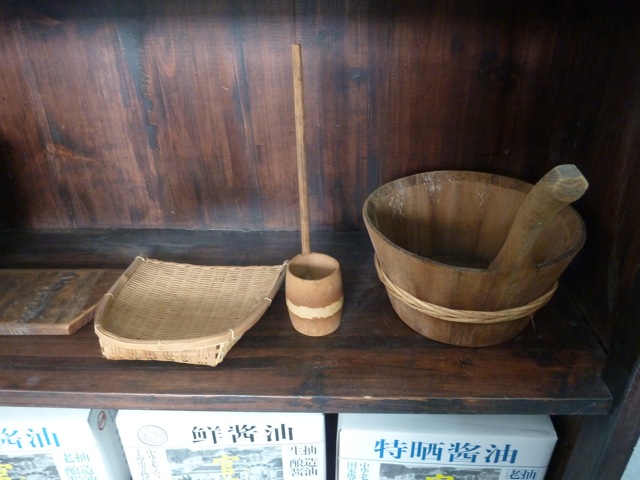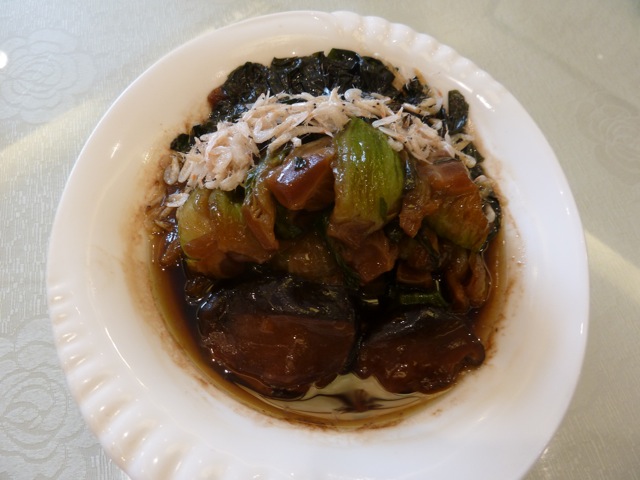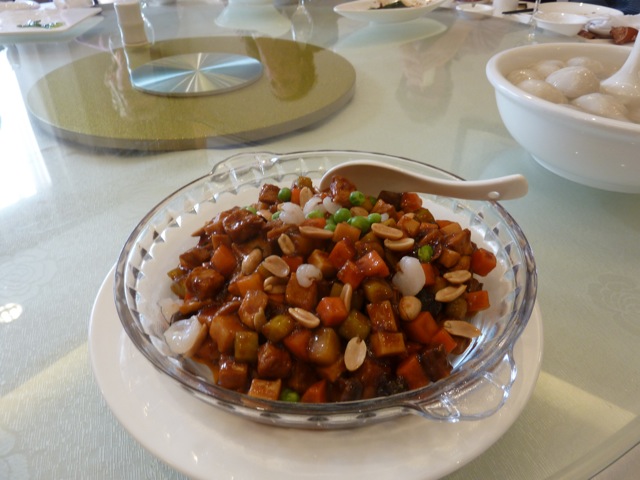Following is a really wonderful trip review from our client regarding her experience in visiting the Heritage Soy-sauce Factory
Shanghai is blessed with the only surviving hand-crafted soy sauce factory in the area, possibly one of the few left in the world. The Handmade Heritage Soy Sauce Factory which makes Guan Jiang Yuan soy sauce was started by the Qian Wan Long family over 130 years ago. Because it has been making soy sauce the same way for so many years it was awarded China’s “Historical Intangible Cultural Heritage” in 2008 which gives it certain protections and aid so that it can continue to operate and remain open.
You see, making soy sauce by hand as they do it in this factory is a long and slow process. As seems to be the case everywhere, soy sauce has fallen victim to mass production. A commercial company like Kikkoman can make a bottle of soy sauce in about 20 days. This place: about 2 years. It’s like the difference between a fine aged cheddar and Velveeta. They have to use a lot of “stuff” (chemicals) in Velveeta to try to get it to imitate cheddar, in a short period of time.
So what makes this company’s soy sauce so different? It’s the fact that it is allowed to age and ferment naturally, rather than doing it at lightening speed by chemical hydrolysis. Interestingly while we were tasting and comparing the handmade and commercially made soy sauces, I was smelling the artisan sauce and I suddenly caught a whiff of something that reminded me of cheese–that kind of yeasty smell.

The main ingredients, soybeans and wheat, are stored in this room. The very high threshold of the door is supposed to keep out rats

First soybeans are cleaned in the pot on the left, then soaked for 12 to 24 hours depending on the time of year.

Then they are steamed in this big contraption

The soybeans are spread out on this table and mixed with wheat, rice and what our guide called the “fungus”. I’m guessing it may actually be a yeast of some sort–perhaps yeast doesn’t translate easily from the Chinese. They use a bamboo scoop for mixing that you will see in a later picture.

The soybeans are spread onto countless bamboo trays to allow the fungus to grow for about 5 days. This is a critical step as the fungus can be killed very quickly if the temperature goes too high in the rooms. The soy master often sleeps here to be sure the temperature is maintained appropriately.

Salt water is then added to the bean and fungus mixture and the whole thing is put into these large clay pots with bamboo covers. Just like oak casks contribute to wine’s flavor, so too do the clay plots contribute to the flavor of the soy sauce.
The soy beans are left in the pots for at least year and stirred every 10 days. It’s at this point that the magic starts to happen. It’s because the pots are exposed to the 4 seasons and the changing weather and temperature that “interesting stuff” happens. Even the sun and the dew contribute to the taste of the soy sauce.

After a year or so, the mash looks quite a lot like something at the bottom of a pit toilet but smells just like soy sauce.

The mash is brought inside and squeezed out using this contraption. The run-off is collected and mixed with more salt water.
The leftover mash is used in two ways; to make another soy type product that I was unfamiliar with and to feed the pigs. There have been times in China’s history during periods of famine, when the leftover mash was used to feed people.

Back into the clay pots the liquid goes for another year for the sun and weather to work their magic. The soy master uses his 30 years of experience to decide when the sauce is perfect.
So the Kikkoman folks? They make up for all that natural sunlight and seasons and dew with msg and artificial colors and other, unpronounceable things. The Soy Factory only uses soybeans for the taste and wheat for the color and sweetness, and nature for all those undefinable flavors.

The soy master, in the middle, will tell you that his soy sauce has more anti aging properties than wine and that the longer it is fermented, the healthier and better tasting it is.
Perhaps there’s something to his claim, because Michael Pollan, author of “The Omnivore’s Dilemma” and guru of all food trends has just been to visit the factory as research for a book on the health benefits of fermented foods.
But there are a billion people in China and this little factory with it’s 400 clay pots can’t produce enough soy sauce for all of them even if they were willing to pay the 40rmb (6.30 USD) price per bottle for the 2 year old cheap stuff or the 200rmb ($32 USD) price for the 3 year old Rolls Royce of soy sauce. The factory workers are thrilled that they now have government support for their factory because they are so proud of the work they are doing and they think it is important to preserve the traditions they are keeping. They are hoping to extend their manufacturing base to other provences to recruit younger people who can keep the traditions alive as all the current workers are getting older.
However, they worry that because soy sauce making by it’s nature is a very slow and meditative process, that it will be boring and unappealing to young people. But, while it seems like a simple process, the soy master would tell you the subtleties of conditions like weather and temperature, make it anything but easy and knowing when a batch of soy sauce is ready to be bottled is the same as knowing when a wine will be in full bloom.

These are antique implements once used in the factory: the bamboo scoopers on the left, to mix the soybeans and fungus, and a ladle that measured out exactly 250ml for customers who were buying the soy sauce

This was the barrel the soy sauce was originally sold from. Now days it’s sold sealed in glass.

This is a priceless Chinese relic, the only one left in China: It is the imperial permit or license to open the soy sauce factory from 130 years ago, necessary because of the large quantities of salt required for production.
All the rest of these licenses were destroyed during the Cultural Revolution, along with all things considered “imperial”, but this one was saved quite by accident. It is made of a very good wood, probably ginko, and a carpenter saw it and wanted it for its wood. So he took it down and hid it in his shop and no one ever found it, thus saving it from destruction.
So, yes this soy sauce is great. There’s just one catch. You can’t buy it. Or maybe you can, once a year at one grocery store in Shanghai, if you happen to know which one and happen to see the line snaking out the door. Otherwise you’re out of luck. They actually bottled some just for us, so we were able to buy some. And only one restaurant, other than their own uses it in their cooking. It just seems a shame that if this is supposed to be such a superior product, it’s actually not available. We were all ready to volunteer some marketing advice to these people!
We were told that as part of our tour, we would get to sample some foods to use with their soy sauce. I guess the Chinese idea of sample and the Western idea of sample are two different things:

We were brought to their restaurant which is in the old factory building

Turnips in soy sauce

Tofu

soy sauce beef

White cut chicken–mostly bones and skin

A shanghai-ese specialty dish, Pudong version with vegetables

tofu skin with vegetable and meat

Sticky rice ball soup–the balls were filled with meat or a sweet bean paste. The insides were fine, but the exterior was a sticky mess. Quite unpleasant.

Eight treasures

Steamed 3 flavor food, a local specialty. Includes quail eggs, pork, dumplings and pig skin. Nobody was too thrilled about the pig skin, but this dish was one of the most delicious of the bunch

ham, bamboo and pork soup: the fancy tower was toppled with chopsticks and stirred to make the soup

Hairy crab. Thankfully we were told we didn’t have to bother with the crabs on top.

We just got to eat these yummy pasta-like bits underneath

duck soy sauce lion head. This very much reminded me of Thanksgiving stuffing, only better.

Green vegetables like only the Chinese know how to make them

Shanghai red beef–the dish I learned to make in my cooking class

fried dumplings





































